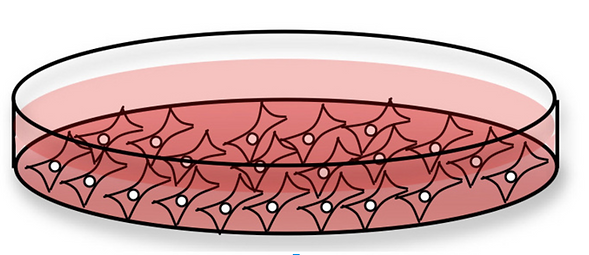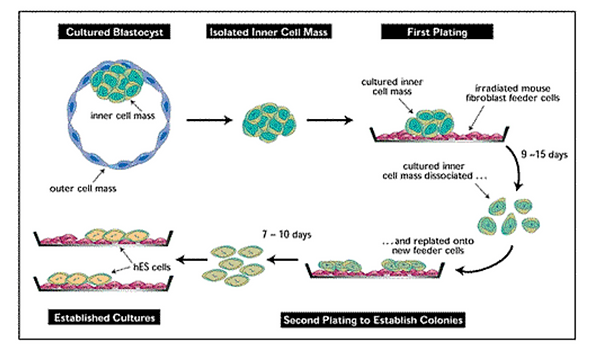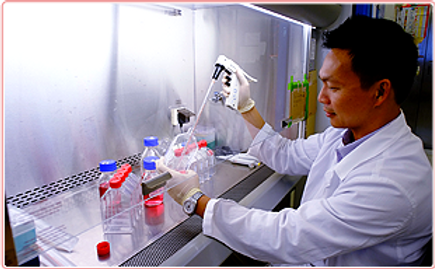STEM ED
In order to better understand stem cells and unlock their incredible potential for science and medicine, researchers need to be able to grow and work with stem cells in a laboratory environment. The techniques used to work with living cells in an in vitro (“in the lab”) environment is called cell culture. By definition, cell culture is the process by which prokaryotic, eukaryotic, and/or plant cells are grown under controlled conditions.
The basic biological concept that is applied in cell culture is “NUTRIENTS IN → WASTE OUT”. Normally in the body, your blood is the main carrier of nutrients and waste products. Therefore, when you are culturing cells in the lab, you need to be able to replicate the mass transport of nutrients and waste products which usually occurs in the body.
In order to keep cells happy, they need to be fed and warm, just like the rest of us— and how we keep them that way is by using culture media. Cell media is the liquid in which cells are cultured, and it's designed to replicate the fluid that cells are swimming around in in your body: it contains things like salts, vitamins, amino acids, and water. Media needs to be made by adding very specific quantities of these reagents together to make ideal conditions to allow cells to grow and divide. Cell media also contains a pH indicator, usually phenol red, which will change color if the cells are not doing as well as they should. For example, if the cells have grown enough to fill the entire plate, they will be using up all the nutrients in the media and putting out a lot of waste, which will turn the media yellow. This gives you a heads up and tells you that you might need to add new media or move the cells to a new plate to give them room to grow by a process called passaging or subculturing. Cell media can sometimes also contain growth factors. Growth factors are small proteins and signaling molecules that can cause the cells to turn on or turn off certain genes and to act in a certain way. Growth factors are especially important when you are culturing stem cells because they are what will either keep the cells undifferentiated (pluripotent) or cause them to differentiate into a new type of cell. Cells are stored at a nice and toasty 37 degrees Celsius (the human body temperature), usually in an incubator.
There are two main growth conditions for the cells: adherent and suspension cultures. Adherent cultures are cells that stick to the bottom of their plate or vessel and create what is called a monolayer, a single layer of cells. In contrast, suspension cultures are free floating, and cells will float around in their media.
Some cells need some help in order to grow; this extra support is called a more complex microenvironment. Some stem cells, such as hESCs, often cannot grow just on a plate and instead require another layer of cells called a feeder layer that helps mimic the cell-cell interactions that they have with other cells in the body.
Cell culture was first established in 1880 when an embryonic chicken was cultured in saline solution. Since then, researchers have been able to culture various types of cell lines from lots of different animals, including mice and humans. Cell culture technology has advanced and changed greatly since it was first implemented with the advancements and discoveries made in science.
Major developments in cell culture technology
-
Using antibiotics in order to stop the growth of contaminants: Since cell culture conditions are made to help things grow, you want to make sure you are only growing the cells that you want! Inventing and using antibiotics allowed for scientists to prevent bacteria that might get into the dish from the air or from other surfaces, like your hands, from growing along with their precious cells.
-
Using trypsin to remove adherent cells from plates: a lot of adherent cells will make proteins that allow them to stick to the plates they get put in. Trypsin is a chemical that breaks down these proteins to release the cells from the plates that they are stuck to so that they can be harvested or moved to a new plate.
-
Developing a chemically defined medium: most stem cell medium contains serum, the part of blood that’s left over after the cells and clotting factors are removed. Serum contains growth factors, lipids, and other essential biological components, but it also potentially contains infectious agents like viruses; it makes media really variable, and it is really expensive. Chemically defined media is “serum-free” and gets rid of the potential problems caused by having medium with serum inside.
An important component of working with cells in the lab is keeping up sterile conditions. This makes sure that the cells you are culturing are the only kinds of cells you have: this means no contamination from bacteria or other cell lines that you might be working with. For this reason, cell culture is done within a flow hood. A flow hood controls the flow of air within a space to prevent contamination from things that can travel by air. Flow hoods often also contain UV lamps. UV light, which you might have heard of as light from the sun, is harmful and can kill bacteria. Also, when you are working with cells, it’s important to use gloves, lab coats, and other personal protective equipment.
Working with Stem Cells in the Lab
LEARN




Looking for more? Check out these other resources!
Learn more about the tools that scientists use to culture cells in the lab with this classroom scavenger hunt! Ask your teacher for more instructions!
Cells are hungry - just like you! Make your own edible media with these instructions! Make sure to have an adult or teacher present.